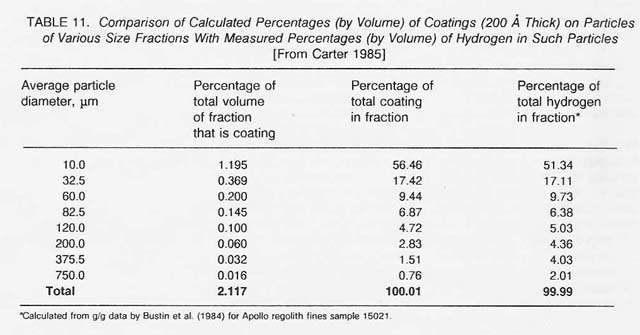
In my 1985 paper I demonstrated that the lunar regolith fines meet the basic requirement for beneficiation because a major portion (a minimum of two-thirds) of the hydrogen, and probably other solar-wind-implanted elements, occurs in the less-than-20- micrometer size fraction-a relatively small part of the fines. A comparison of the lunar data of Bustin et al. (1984) with the results of my theoretical calculations (table 11) reveals excellent similarity, except for a slight but significant increase of hydrogen in the size fractions that are greater than 120 micrometers. This enrichment of the lunar samples is due to the presence of constructional particles (McKay et at. 1971, Carter 1971); namely, agglutinates (DesMarais, Hayes, and Meinschien 1974) and other types of dust-welded particles.

One aspect of the question of economics is how difficult and expensive it is
to extract the solar- wind-implanted elements from the beneficiated lunar regolith
fines. In 1985 I recalculated the hydrogen thermal release pattern for a sample
of Apollo 11
regolith fines (10086) (Gibson and Johnson 1971) and found that approximately
81 percent of the hydrogen is released below 600°C. This calculation means
that only a moderate amount of thermal energy should be required to extract
a significant portion of the hydrogen, especially if advantage can be taken
of anytime temperature on the lunar surface and if heat can be recycled to preheat
the beneficiated fines. However, I also demonstrated that the amount of material
that would have to be processed to supply 1 metric ton of hydrogen is significant,
even when all efforts have been made to enhance the production. I found that,
for the 63 percent of the hydrogen that occurs in the less-than-20- micrometer
size fraction of Apollo 15 sample 15021 (Bustin et al. 1984), a minimum of 19
596 metric tons of lunar regolith fines would have to be processed, with 4507
metric tons of concentrate heated, yielding a recovery of 51 percent of the
hydrogen. Although these tonnages are not high by terrestrial standards, they
will probably limit production of hydrogen in the early exploitation of the
lunar regolith fines to that obtained as a byproduct or coproduct from the mining
and processing of other materials. The production of two or more products at
the same time may be the best way to reduce costs to economical levels
(Criswell 1980, Simon 1985).
It is also interesting to speculate on bringing back to Earth valuable elements, compounds, or minerals. However, the only element, compound, or mineral that by itself has economic potential for mining, processing, and return to Earth is 3He (Wittenberg, Santarius, and Kulcinski 1986). It is very expensive to transport materials from Earth and put together an infrastructure on the lunar surface (Simon 1985). It takes at least $25 000 in 1987 dollars to deliver a pound of material to the lunar surface, which is approximately 5 times the value of a pound of gold on Earth!
In 1966, before a man walked on the Moon, Peter Flawn was insightful when he wrote,
Because of the acceleration of change in the last half-century, this writer is not inclined to state categorically that mineral materials will never be transported through space from an extra-terrestrial source to earth. It is, however, difficult to conceive of the system under which such an enterprise could take place. Mining of local materials around extra- terrestrial bases, however, is something entirely different and makes good sense. The pioneers on earth found that where transportation facilities were nonexistent or where they were prohibitively expensive, they had to make do with local materials. Space pioneers will be in the same situation. Use of local minerals for sources of oxygen, for energy, and for materials will undoubtedly be more economical than large-scale transport from earth. Thus although extra-terrestrial minerals are not likely to be a source for augmenting earth supplies, they are a source which will reduce by minute amounts the export of earth minerals.
These thoughts still apply. Moreover, the comments on transportation of nonterrestrial mineral materials to Earth should remain valid at least until a significant infrastructure is in place on the lunar surface.
Next
![[NASA]](images/NASAball.gif)
![[Ames Research Center]](images/arclogo1.gif)
|
WebWork: Al Globus, Bryan Yager, and Tugrul Sezen |
![[LifeSciences]](images/lslogot.gif)
![[Space Settlement]](images/splogosm.gif)
|